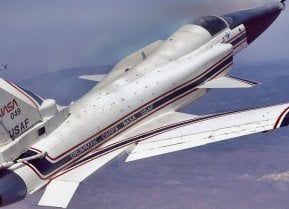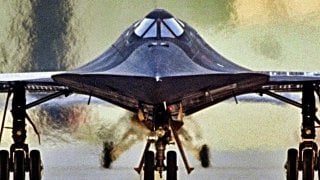The SR-71 Blackbird Was So Fast It Could Out Run Missiles
The SR-71 achieved a record top speed of 2,193 mph – while other aircraft could reach such extreme speeds in theory – but would melt due to the atmospheric friction and heat – the Blackbird could maintain it for extended periods.
SR-71 Blackbird Outran Thousands of Missiles - The Lockheed SR-71 Blackbird is remembered for being a fast plane – able to fly more than 2,200 mph (Mach 3+ or more than three times the speed of sound), and at altitudes greater than 85,000 feet.
During the aircraft's nearly 25 years in service, the SR-71 set numerous speed records, and on July 28, 1976, a Blackbird reached an impressive 2,193.167 miles per hour. Flying at roughly 36.55 miles per minute, or 3,216.4 feet per second, it was faster than a bullet fired from the World War II-era M1 Garand rifle, which had a muzzle velocity of 2,800 feet per second.
The SR-71 achieved a record top speed of 2,193 mph – and while other aircraft could reach such extreme speeds in theory – but would melt due to the atmospheric friction and heat – the Blackbird could maintain it for extended periods. It still holds the record for a cross-country flight, traveling from Los Angeles to Washington, D.C. in just 64 minutes, 20 seconds.
In addition to flying fast, the SR-71 also set an altitude record – reaching 25,929 meters. It flew so high that pilots navigating by sight couldn't even rely on ground features such as roads and instead needed to look at the mountains, rivers, and major coastlines to get their bearings.
While it sounds like a dream job, it was very serious business – as the SR-71 was designed as a long-range, high-altitude, strategic reconnaissance aircraft. Mission equipment for the plane's aerial reconnaissance role included signals intelligence sensors, side-looking airborne radar, and a camera.
The two-person crew – the pilot and reconnaissance systems officer (RSO) – weren't carefree tourists in the sky, however.
"As the SR-71 approached the sensitive area, each crew member became more focused, gaining an increased sense of awareness. The sensitive area was airspace where anything and everything was possible. It might be Soviet MiGs trying to intercept the plane or SAMs launched in an attempt to shoot down the SR-71," wrote Col. Richard H. Graham, United States Air Force Retired, in his book SR-71: The Complete Illustrated History of The Blackbird – the World's Highest, Fasted Plane (Zenith Press, 2013).
"The pilot's main job in the sensitive area was flying the aircraft smoothly to get good imagery and watching outside the windows for visual signs of impending threats from aircraft contrails or SAMs being fired," added Graham, who flew the aircraft for seven years, spending 756 hours in the cockpit.
Yes, it Could Outrun Missiles
The SR-71 earned its reputation for incomparable speed.
No aircraft could catch it, and neither could missiles. A dozen Blackbirds were lost to accidents during its service history, but not a single aircraft was shot down by an enemy. Though the aircraft carried radar countermeasures to evade interception efforts, the Blackbird's great protection was still its combination of very high speed and high altitude. It also had a low radar cross-section, which gave a very short time for an enemy surface-to-air missile (SAM) to acquire and track the aircraft.
By the time a SAM site could track the Blackbird, it was out of range. In theory that made it almost invulnerable. Moreover, if a SAM site was able to track the SR-71 and fire a missile, the aircraft flew high enough to evade it.
Efforts Were Made to Shoot Down the SR-71
Those on the ground still tried their best, and during its service history, the SR-71 reportedly evaded some 4,000 missiles fired its way.
As previously reported, around 800 missiles were fired at Blackbirds over Vietnam alone—but not a single one was lost to enemy fire. One came close, and a CIA A-12 did take a piece of shrapnel from an SA-2 missile that exploded 100 meters away. In addition, SR-71 pilots did report that missiles launched without radar guidance and no launch detection had passed as close as 150 yards (140 m) from the aircraft.
Blackbird pilot Brian Shul explained that on the mission over Libya on April 15, 1986, the aircraft was pushed to Mach 3.5 to evade a missile.
The Blackbird had crossed into Libya and was approaching its final turn over the bleak desert landscape when Major Walter Watson, the aircraft's reconnaissance systems officer (RSO), informed Shul that he was receiving missile launch signals. Shul quickly increased our speed, calculating the time it would take for the weapons – most likely SA-2 and SA-4 surface-to-air missiles capable of Mach 5 – to reach the altitude of the SR-71. Shul quickly estimated that the Blackbird could beat the rocket-powered missiles to the turn and stayed our course. He noted that he was betting his and Watson's lives on the aircraft's performance.
"The plane was flying a mile every 1.6 seconds, well above our Mach 3.2 limit. It was the fastest we would ever fly," Shul wrote, adding that after several agonizingly long seconds, Watson suggested, "You might want to pull it back."
Shul noted the throttles were still full forward. "I pulled the throttles to idle just south of Sicily, but we still overran the refueling tanker awaiting us over Gibraltar."
The U.S. Air Force retired its fleet of SR-71s on Jan. 26, 1990, because of a decreasing defense budget and high costs of operation. There was a brief reactivation with a final retirement in 1999.
Author Experience and Expertise
Peter Suciu is a Michigan-based writer. He has contributed to more than four dozen magazines, newspapers, and websites with over 3,200 published pieces over a twenty-year career in journalism. He regularly writes about military hardware, firearms history, cybersecurity, politics, and international affairs. Peter is also a Contributing Writer for Forbes and Clearance Jobs. You can follow him on Twitter: @PeterSuciu.


